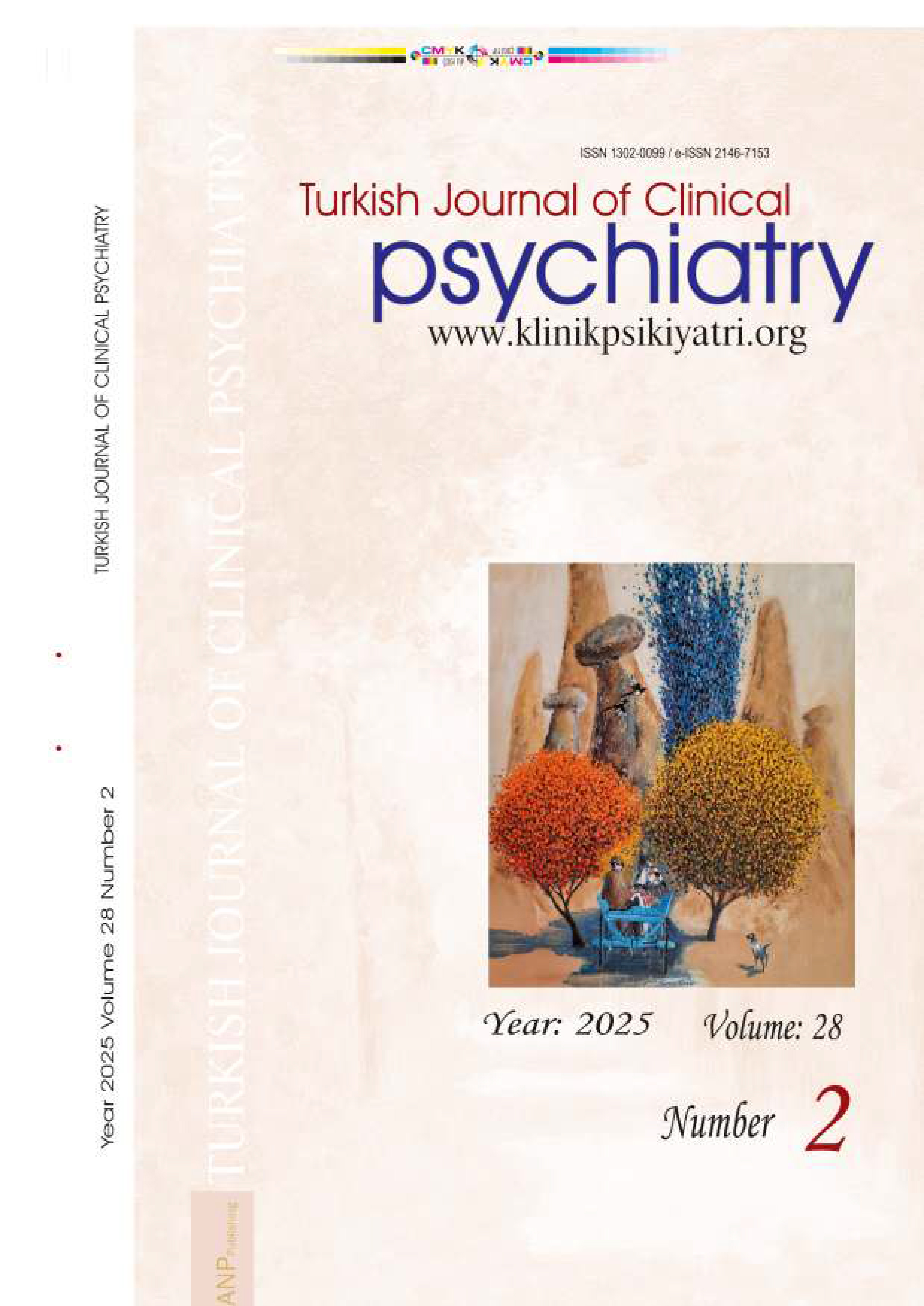





Volume: 8 Issue: 4 - 2005
| RESEARCH ARTICLE | |
| 1. | The Electrophysiology of Performance in the Stroop Test: Event-Related Potentials and Brain Maps Sirel Karakaş, Belma Bekçi, Elvin Doğutepe, Utku Erzengin Pages 155 - 171 Objective: To find the cognitive correlates and the brain regions that performance on Stroop Test represent. Method: The study was conducted on 45 healthy volunteers who were matched with respect to age (19-37 years) and education (12 years or more). Stimulation, recording and analyses were carried under NeuroScan 4.2. Computerized versions of the Stroop Test were used. EEG was recorded from 32 electrode locations (10/20 system, referenced to linked earlobes) and filtered between 0.16-100 Hz (3 dB point, 12 dB octave/slope). Total record time was 2046 ms and the first 1024 ms comprised the prestimulus interval which was also be used for baseline correction. Sampling rate was 512 Hz. The analyses were carried on in the time-domain (event- related potentials: ERPs). Respective time-domain maps were constructed. The effect of the experimental conditions and electrode locations on ERP peaks were statistically analyzed. Results: In this test, early ERP and high frequency ERO components were obtained mainly from the posterior recording sites and represented sensory/perceptual processes. The late ERP and the low frequency ERO components, on the other hand, represented higher operations of information processing. Conclusion: Performance at the Stroop Test involve extended regions of the brain. These findings support the contemporary models on brain and cognition according to which functions are realized through selectively distributed processing. |
| 2. | Prevalence of Hypersomnia-Related Symptoms in an Urban District of Ankara Selçuk Aslan, Sinan Yetkin, Selda Albayrak, Zeynep Gülcat, Işıl Maral, Sefer Ayçan, Levent Sütcigil, Fuat Özgen, Hamdullah Aydın Pages 172 - 179 Objective: The characteristics and prevalence of hypersomnia-related sleep problems in Turkey are not well established. The goal of this study was to determine the prevalence of hypersomnia-related symptoms in an urban district of Turkey. Method: Out of the 1332 people in the sample, 1034 subjects in the 15-65 years age range were included in the study. Interviews were conducted according to the "Sleep Disorders Assessment Questionnaire" developed by the researchers, and the Epworth Sleepiness Scale (ESS) was administered to the subjects. Results: The mean age of the participants was 34.28 12.30 with a 45.3% male, 54.7% female distribution, 6.9% defined one or more hypersomnia symptoms (daytime somnolence or excessive daytime sleepiness or more than 11 hour night-time sleep). The distribution of the reported symptoms were as follows: daytime somnolence 4.2%, more than 11 hour night-time sleep 3.6%, restless legs while falling asleep %6.1, continuous loud snoring %15.8, and breathing cessation during sleep 7.9%. ESS revealed that 2.3% of the participants suffered from excessive daytime sleepiness. Subjects with chronic physical disorders, overweight subjects, and subjects older than 40 years old had more excessive daytime sleepiness. Conclusion: This study collected information on the prevalence of hypersomnia related symptoms in an urban community sample in Turkey. Future studies should use a structured clinical interview and sleep laboratory studies on selected patients to establish a more reliable diagnosis of sleep disorders. |
| 3. | Increased Xanthine Oxidase and Malondialdehyde Levels in Euthymic Bipolar Patients Haluk Savaş, Serdar Gergerlioğlu, Ahmet Gürel, Salih Selek, Esen Savaş, Esra Koçoğlu, Murat Eren Özen, Hasan Herken, Ömer Akyol Pages 180 - 185 Objectives: There hasn't been any study measuring (Xanthine Oxidase), and MDA (Malondialdehyde) enzymes in euthymic bipolar disorders yet. In bipolar patients, MDA levels were already known to be high. In remission phase (euthymic phase), XO and MDA, are not known to be whether high or low. In this study, we aimed to find out levels of these molecules in euthymic episode of Bipolar Disorder. Method: Twenty-two patients with bipolar disorders (İB) in euthymic phase and twenty-two healthy control subjects were included in this study. XO, and MDA have been studied in serum. DSM-IV based (Diagnostic and Statistical Manual of Mental Disorders) diagnosis of BD and being at least for a month in euthymic phase was established by a psychiatrist. Results: The mean value of patients' serum XO levels was significantly higher than those of the controls. Mean serum MDA levels were found to be increased in patients compared to controls. There is a correlation between XO and MDA levels. Conclusion: High XO and MDA levels in BD (Type l-Euthymic phase) may show that the disease still continues with oxidative stress in molecular level, when combined with the previous findings of high oxidative stress in acute manic phase of BD. |
| 4. | The Validity and Reliability of the Turkish version of Selçuk Aslan, Hakan Türkçapar, Mustafa Uğurlu, Görkem Karakaş Pages 186 - 196 Objective: This study was designed to examine the validity and reliability of this schedule for assessing the Turkish version of "Beck Cognitive Insight Scale" in a Turkish schizophrenic patient population. A composite index of the BCIS reflecting cognitive insight was calculated by subtracting the score for the self-certainty scale from that of the self-reflectiveness scale. Method: Eighty-one inpatients with chronic schizophrenia were included in the study. All patients were interviewed in remission after exacerbation. The interviewers were administered Turkish version of schedule for assessing the three components of insight (SAI), Brief Psychiatric Rating Scale (BPRS), routine mental examination, and the Beck Cognitive Insight Scale (BCIS) were completed by patient. Two days later in the second occasion patients completed the BCIS. Results: The two sub-dimension of insight scale internal consistency measured by cronbach alfa (0.56), (0.50) respectively. Test-retest reliability show high correlation ((r=0.86, p<0.001) for self-reflectivity and self-certainty subscale (r=0.86, pcO.001). To estimate the concurrent validity of scale the correlation among composite index of BCIS and subscales and SAI were computed, composite index found to be valid (r=0.29, p=0.023) in the Turkish schizophrenic patient population to the same extent as the SAI insight scale. Self certainty subscale have significant negative correlation with SAI (r=-0.28, p=0.025). Conclusion: Results revealed tentative support for the validity and reliabilty of Turkish version of BCIS. |
| CASE REPORT | |
| 5. | Tourette Syndrome after Mumps Meningoencephalitis: A Case Report Osman Sabuncuoğlu, Meral Berkem Pages 197 - 200 Tourette syndrome (TS) is an important childhood-onset neuropsychiatric disorder that is characterized by non- rythmic, sudden, rapid, involuntary, repetitive motor and vocal tics. It is now known that the symptoms of TS may emerge secondary to identified events such as infection, stroke and medication use. In this case report, we present a 9-year-old boy who developed motor and vocal tics 2 months after a mumps infection complicated by meningoencephalitis. A careful history taken from the mother and the child, and a detailed psychiatric examination revealed that the patient had displayed eye blinking, eye rolling, mouth twisting, head and shoulder jerking, finger-hand flexing, repetitive touching, throat clearing, coughing, sniffing, gasping, echolalia and stammering. He obtained a score of 30 on the Yale Global Tic Severity Scale, which indicated a markedly severe presentation. This patient did not have comorbid Attention-Deficit/Hyperactivity Disorder and Obsessive Compulsive Disorder. A family history of tics and findings of pediatric neuropsychiatric disorder associated with streptococcal infection were absent. There was also a significant deterioration in the patient's academic performance during the course of the disorder. This case report is important because it describes the first patient with mumps-associated TS and significant improvement with risperidone treatment. Secondary TS may contribute to the better understanding of this developmental neuropsychiatric disorder in general. Further studies are required in order to understand the interaction between genetic susceptibility and secondary factors in the development of the symptoms of TS. |










